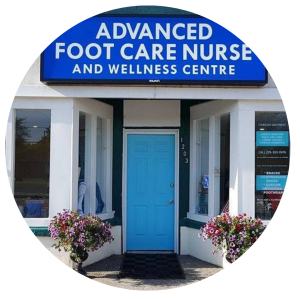

Calluses are one of nature’s ways of protecting our bodies, especially when occurring on the hands and feet. Simply stated, calluses are a build-up of skin, typically over a bony prominence where repetitive, minor trauma has occurred over time. Athletes, manual laborers, guitar players, dancers, or anyone who uses their hands or feet regularly has likely experienced callus formation as it pertains to their relevant activity. Calluses are also known as “hyperkeratotic lesions” and in some instances, “pre-ulcerative lesions”. They are thick skin pads that reduce shearing, torque and the likelihood of a break in the skin that can lead to infection or more extensive damage.
A simple way to illustrate how things can go from good to bad where calluses are concerned, is to take one finger, and press it against the palm of your hand for 5 seconds, then release. You’ll likely notice an area of blanching followed by a return of color to the area where pressure had been applied. The temporary blanching is caused by the pressure from your finger reducing the blood supply to the skin. When you released your finger, blood and normal color returned.
If skin on the bottom of the foot or surface of a toe develops a callus over a bony prominence, there should be concern, especially when diabetes is also present. The callus that developed to protect the underlying bone can often create increased pressure underlying the skin, resulting in reduced blood flow to the area. Since the main function of red blood cells is to deliver oxygen, reducing blood flow to the skin by way of a callus development can lead to death of skin cells and hence, the beginning of an ulcer.
Diabetics are especially at risk for ulceration for several reasons, including the loss of protective sensation when peripheral neuropathy (damage to the nerves that supply the skin) is involved.
Imagine having a pebble inside your shoe. Walking several steps will become reason to stop and remove the shoe and pebble, in an otherwise healthy person. The pain that was temporarily present when the pebble was causing irritation was the body protecting you from more serious injury, such as a blister or possibly an open sore. Someone with diabetes and/or neuropathy may not be able detect the presence of a pebble, and over the course of a few minutes, not to mention hours or days, can suffer serious injury from something so relatively benign.
A callus on a toe or foot represents a similar potential danger, analogous to the pebble inside the shoe. When someone with diabetes and neuropathy develops such a callus, the underlying tissue not only receives less blood flow and oxygen, but the trauma over the course of days and weeks can result in the breakdown of skin at the site. The breakdown of the skin from the reduced blood flow and repetitive trauma is how an ulcer can form. If such an ulcer results, this can become the pathway to amputation should infection or slow healing ensue.
Never attempt self-treatment. I have seen patients over the years who developed ulcers and infections after attempting to manage their calluses at home. Over the counter treatments, such as moleskin pads, may contain salicylic acid, which can cause further injury to the skin in the process of attempting to soften or loosen the callus.
Likewise, attempting to trim calluses with a pocketknife, for example, while working at an awkward angle (sometimes referred to as “Saturday night bathroom surgery”) is a recipe for disaster. I wish these examples were products of my imagination, but they are firsthand accounts and often the reality of what precedes a visit to a hospital emergency department. The best way to manage calluses then is a strategy that involves professional care, protective insoles and daily skin care.
Professional care, especially when diabetes is present, should be in the form of annual if not more frequent visits to a Foot Care Professional team. Our team can not only trim (debride) calluses, but can also check blood flow, nerve function and assess for additional risk factors. They can also prescribe protective or custom insoles or orthotics that can accommodate and reduce pressure areas to slow the return of recurrent callus formation.
Cushioned socks (often sold as “diabetic socks”) can help reduce pressure and shear, as well as help disperse excessive moisture (that can cause maceration), away from the surface of the skin.
Ultimately, the individual can play an active role in the prevention of foot ulcers when calluses are present. The simple act of inspecting the feet twice a day, cannot be emphasized enough. Looking for redness surrounding a callus is one example. If bloody, clear or foul-smelling drainage is present on a sock or floor (for those not wearing shoes around the house) the source may be from an existing callus. Such a scenario can represent an underlying infection, and immediate medical attention is a must.
Part of the daily skin care routine, besides inspection, is moisturizing of skin. After bathing in the morning and in the evening before bed, applying an emollient to the skin can help reduce the intensity of calluses and make skin more supple. A skin cream or protectant that does not contain alcohol is recommended. It’s also a great way to further inspect the feet, as feeling for irregularities in addition to visualizing the potentially problematic areas, can provide a much more thorough assessment.

GET IN TOUCH WITH US

MONDAY: 9:00AM – 5:00PM
TUESDAY 9:00AM – 5:00PM
WEDNSDAY 9:00AM – 7:00PM
THURSDAY 9:00AM – 5:00PM
FRIDAY 9:00AM – 5:00PM
SATURDAY 9:00AM – 4:00PM
SUNDAY 10:00AM – 2:00PM
Email:
info@advancedfootnurse.com
Fax Number: (226) 216-5402
| Cookie | Duration | Description |
|---|---|---|
| cookielawinfo-checkbox-analytics | 11 months | This cookie is set by GDPR Cookie Consent plugin. The cookie is used to store the user consent for the cookies in the category "Analytics". |
| cookielawinfo-checkbox-functional | 11 months | The cookie is set by GDPR cookie consent to record the user consent for the cookies in the category "Functional". |
| cookielawinfo-checkbox-necessary | 11 months | This cookie is set by GDPR Cookie Consent plugin. The cookies is used to store the user consent for the cookies in the category "Necessary". |
| cookielawinfo-checkbox-others | 11 months | This cookie is set by GDPR Cookie Consent plugin. The cookie is used to store the user consent for the cookies in the category "Other. |
| cookielawinfo-checkbox-performance | 11 months | This cookie is set by GDPR Cookie Consent plugin. The cookie is used to store the user consent for the cookies in the category "Performance". |
| viewed_cookie_policy | 11 months | The cookie is set by the GDPR Cookie Consent plugin and is used to store whether or not user has consented to the use of cookies. It does not store any personal data. |